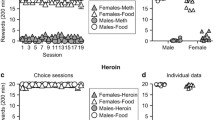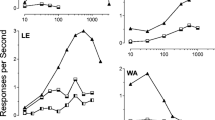Abstract
The purpose of the present study was to evaluate behavioral and pharmacological determinants of smoked heroin self-administration. Eight rhesus monkeys were trained to self-administer smoked heroin under a chained fixed-ratio (FR, 64-1024) for lever presses, FR 5 for inhalations schedule during daily experimental sessions. Demand for heroin was determined by plotting consumption (smoke deliveries) as a function of price which was varied by increasing the FR lever press requirement from 64 to 1024. The heroin demand curve was compared to that obtained with smoked cocaine base. Dose-effect determinations were obtained by varying the unit dose of heroin from 0.025 to 1.6 mg/kg per delivery. Pretreatment with naloxone (0.01–1.0 mg/kg IM, 10 min presession) and substitution tests with the peripherally acting opioid loperamide (0.1 mg/kg per delivery) were also conducted. Deliveries of smoked heroin decreased, but lever responding per delivery increased as the FR increased. Demand for heroin was elastic and comparable to demand for smoked cocaine base. Varying the dose of heroin available for self-administration resulted in an asymptotic dose-effect curve. Naloxone pretreatment produced dose-dependent decreases in heroin self-administration. Substitution of loperamide for heroin produced extinction-like responding within one or two sessions, with the total smoke deliveries decreasing by 80% of heroin levels within 8–15 days. Reinstatement of heroin resulted in a rapid return to baseline levels of self-administration. These data suggest that rhesus monkeys will readily and reliably self-administer heroin via the inhalation route, and behavioral and pharmacological manipulations indicate that smoked heroin functioned as a positive reinforcer.
Similar content being viewed by others
References
Awouters F, Megens A, Verlinden M, Schuurkes J, Niemegeers C, Janssen PAJ (1993) Loperamide: survey of studies on mechanism of its antidiarrheal activity. Digest Dis Sci 38: 977–995
Bickel WK, DeGrandpre RJ (1995) Price and alternatives: suggestions for drug policy from psychology. Int J Drug Policy 6: 93–105
Bickel WK, DeGrandpre RJ, Higgins ST (1993) Behavioral economics: a novel experimental approach to the study of drug dependence. Drug Alcohol Depend 33: 173–192
Carroll ME (1982) Rapid acquisition of oral phencyclidine self-administration in food-deprived and food-satiated rhesus monkeys. Pharmacol Biochem Behav 17: 341–346
Carroll ME, Stotz DC (1983) Orald-amphetamine and ketamine self-administration by rhesus monkeys: effects of food deprivation. J Pharmacol Exp Ther 227: 28–34
Carroll ME, Stotz DC, Kliner DJ, Meisch RA (1984) Self-administration of orally-delivered methohexital in rhesus monkeys: effects of food deprivation and satiation. Pharmacol Biochem Behav 20: 145–151
Carroll ME, Krattiger KL, Gieske D, Sadoff DA (1990) Cocaine-base smoking in rhesus monkeys: reinforcing and physiological effect. Psychopharmacology 102: 443–450
Colpaert FC, Niemegeers CJE, Lal H, Janssen PAJ (1975) Investigations on drug produced and subjectively experienced discriminative stimuli. Life Sci 16: 717–728
Comer SD, Hunt VR, Carroll ME (1994) Effects of concurrent saccharin availability and buprenorphine pretreatment on demand for smoked cocaine base in rhesus monkeys. Psychopharmacology 115: 15–23
Dajani EG, Bianchi RG, East PF, Bloss JL, Adelstein GW, Yen CH (1977) The pharmacology of SC-27166: a novel antidiarrheal agent. J Pharmacol Exp Ther 203: 512–526
Gliagnoni G, Casiraghi L, Senini R, Revel L, Parolaro D, Sala M, Gori E (1983) Loperamide: evidence of interaction with mw and delta opioid receptors. Life Sci 33: 315–318
Griffiths P, Gossop M, Powis B and Strang J (1994) Transitions in patterns of heroin administration: a study of heroin chasers and heroin injectors. Addiction 89: 301–309
Harrigan SE, Downs DA (1978a) Self-administration of heroin,l-acetylmethadol, morphine and methadone in rhesus monkeys. Life Sci 22: 619–624
Harrigan SE, Downs DA (1978b) Continuous intravenous naltrexone effects on morphine self-administration in rhesus monkeys. J Pharmacol Exp Ther 204: 481–486
Henningfield JE, Meisch RA (1976) Drinking device for rhesus monkeys. Pharmacol Biochem Behav 4: 409–610
Hursh SR, Bauman RA (1987) The behavioral analysis of demand. In: Green L, Kagel JH (eds) Advances in behavioral economics (vol. 1). Ablex, Norwood, N.J., pp 117–165
Jaffe JH, Kanzler M, Green J (1980) Abuse liability of loperamide. Clin Pharmacol Ther 28: 812–819
Jaffe JH, Martin WR (1990) Opioid analgesics and antagonists. In: Gilman AG, Rall TW, Nies AS, Taylor P (eds) The pharmacological basis of therapeutics, 8th edn. Pergamon Press, New York, pp 485–521
Jenkins AJ, Keenan RM, Henningfield JE, Cone EJ (1994) Pharmacokinetics and pharmacodynamics of smoked heroin. J Anal Toxicol 18: 317–330
Kramer TH, Fine J, Ottomanelli G, Schwartz R (1991) Chasing the dragon: a wider perspective. J Subst Abuse Treat 8: 303
Mello NK, Bree MP, Mendelson JH (1983) Comparison of buprenorphine and methadone effects on opiate self-administration in primates. J Pharmacol Exp Ther 225: 378–386
Negus SS, Henrikson SJ, Mattox AJ, Pasternak GW, Portoghese PS, Takemori AE, Weinger MB, Koob GF (1993) Effect of antagonists selective for mu, delta and kappa opioid receptors on the reinforcing effects of heroin in rats. J Pharmacol Exp Ther 265: 1245–1252
Niemegeers CJE, McGuire JL, Heykants JJP, Janssen PAJ (1979) Dissociation between opiate-like and antidiarrheal activities of antidiarrheal drugs. J Pharmacol Exp Ther 210: 327–333
Office of National Drug Control Policy (1995) Pulse Check, national trends in drug abuse. Executive Office of the President, Washington, pp 7–9
Roberts DCS, Bennett SAL (1993) Heroin self-administration in rats under a progressive ratio schedule of reinforcement. Psychopharmacology 111: 215–218
Takasuna M, Negus, SS, DeCosta, BR, Woods, JH (1994) Opioid pharmacology of the antinociceptive effects of loperamide in mice. Behav Pharmacol 5: 189–195
US Department of Health and Human Services, Office of Applied Studies, Substance Abuse and Mental Health Services Administration (1994a) National Household Survey: Population Estimates 1993
US Department of Health and Human Services, Office of Applied Studies, Substance Abuse and Mental Health Services Administration (1994b) Preliminary estimates from the drug abuse warning network. Advance Report Number 8
Wurster RM, Griffiths RR, Findley JD, Brady JV (1977) Reduction of heroin self-administration in baboons by manipulation of behavioral and pharmacological conditions. Pharmacol Biochem Behav 7: 519–528
Wuster M, Herz A (1978) Opiate agonist action of antidiarrheal agonists in vitro and in vivo-findings in support of selective action. Naunyn-Schmiedeberg's Arch Pharmacol 301: 187–194
Yanagita T, Miyasato K, Sato J (1980) Dependence potential of loperamide studied in Rhesus monkeys. In: Harris LS (ed) Problems of drug dependence 1979. National Institute on Drug Abuse, US Goverment Printing Office, Washington, pp 106–113
Young AM, Swain HH, Woods JH (1981) Comparison of opioid agonists in maintaining responding and in suppressing morphine withdrawal in rhesus monkeys. Psychopharmacology 74: 329–335
Author information
Authors and Affiliations
Rights and permissions
About this article
Cite this article
Mattox, A.J., Carroll, M.E. Smoked heroin self-administration in rhesus monkeys. Psychopharmacology 125, 195–201 (1996). https://doi.org/10.1007/BF02247328
Received:
Revised:
Issue Date:
DOI: https://doi.org/10.1007/BF02247328




